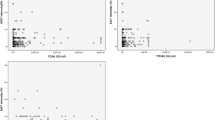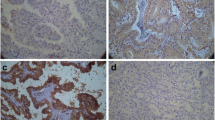Abstract
Objective
Keratin 15 (KRT15) is identified as a useful biomarker in several solid tumors, while its clinical role in papillary thyroid cancer (PTC) remains unknown. Herein, this study is intended to explore the correlation of tumor KRT15 with clinical features and survival in PTC patients who received tumor resection.
Methods
This study retrospectively screened 350 PTC patients who received tumor resection and 50 thyroid benign lesions (TBL) patients. KRT15 in formalin-fixed paraffin-embedded lesion specimens of all subjects was detected by immunohistochemistry (IHC).
Results
KRT15 was reduced in PTC patients compared to TBL patients (P < 0.001). Furthermore, KRT15 was negatively associated with tumor size (P = 0.017), extrathyroidal invasion (P = 0.007), pathological tumor (pT) stage (P < 0.001), and postoperative radioiodine application (P = 0.008) in PTC patients. Regarding prognostic value, high KRT15 (cut-off by an IHC value of 3) is linked with prolonged accumulating disease-free survival (DFS) (P = 0.008) and overall survival (OS) (P = 0.008) in PTC patients. Also, the multivariate Cox regression model showed that high KRT15 (vs. low) was an independent factor for longer DFS (hazard ratio = 0.433, P = 0.049), but not for OS (P > 0.050) in PTC patients. Subgroup analyses revealed that KRT15 possessed a better prognostic value in PTC patients with age ≥ 55 years, tumor size > 4 cm, pathological node stage 1, or pathological tumor-node-metastasis stage ≤ 2 (all P < 0.050).
Conclusion
Increased tumor KRT15 associates with a lower invasive degree, prolonged DFS, and OS, revealing its prognostic utility in PTC patients undergoing tumor resection.




Similar content being viewed by others
References
Miranda-Filho A, Lortet-Tieulent J, Bray F et al (2021) Thyroid cancer incidence trends by histology in 25 countries: a population-based study. Lancet Diabetes Endocrinol 9(4):225–234. https://doi.org/10.1016/S2213-8587(21)00027-9
Seib CD, Sosa JA (2019) Evolving understanding of the epidemiology of thyroid cancer. Endocrinol Metab Clin North Am 48(1):23–35. https://doi.org/10.1016/j.ecl.2018.10.002
Filetti S, Durante C, Hartl D et al (2019) Thyroid cancer: ESMO clinical practice guidelines for diagnosis, treatment and follow-updagger. Ann Oncol 30(12):1856–1883. https://doi.org/10.1093/annonc/mdz400
Haddad RI, Bischoff L, Ball D et al (2022) Thyroid carcinoma, version 2.2022, NCCN clinical practice guidelines in oncology. J Natl Compr Canc Netw 20(8):925–951. https://doi.org/10.6004/jnccn.2022.0040
Lee J, Lee SG, Kim K et al (2019) Clinical value of lymph node ratio integration with the 8(th) edition of the UICC TNM classification and 2015 ATA risk stratification systems for recurrence prediction in papillary thyroid cancer. Sci Rep 9(1):13361. https://doi.org/10.1038/s41598-019-50069-4
Rui ZY, Liu Y, Zheng W et al (2021) A retrospective study of the risk factors and the prognosis in patients with papillary thyroid carcinoma depending on the number of lymph node metastasis. Clin Exp Med 21(2):277–286. https://doi.org/10.1007/s10238-020-00675-8
Wagner K, Abraham E, Tran B et al (2020) Lymphovascular invasion and risk of recurrence in papillary thyroid carcinoma. ANZ J Surg 90(9):1727–1732. https://doi.org/10.1111/ans.16202
Ulisse S, Baldini E, Lauro A et al (2021) Papillary thyroid cancer prognosis: an evolving field. Cancers (Basel) 13(21). https://doi.org/10.3390/cancers13215567
Waseem A, Dogan B, Tidman N et al (1999) Keratin 15 expression in stratified epithelia: downregulation in activated keratinocytes. J Invest Dermatol 112(3):362–369. https://doi.org/10.1046/j.1523-1747.1999.00535.x
Chen W, Miao C (2022) KRT15 promotes colorectal cancer cell migration and invasion through beta-catenin/MMP-7 signaling pathway. Med Oncol 39(5):68. https://doi.org/10.1007/s12032-021-01619-2
Giroux V, Stephan J, Chatterji P et al (2018) Mouse intestinal Krt15+ Crypt cells are radio-resistant and tumor initiating. Stem Cell Reports 10(6):1947–1958. https://doi.org/10.1016/j.stemcr.2018.04.022
Tai G, Ranjzad P, Marriage F et al (2013) Cytokeratin 15 marks basal epithelia in developing ureters and is upregulated in a subset of urothelial cell carcinomas. PLoS One 8(11):e81167. https://doi.org/10.1371/journal.pone.0081167
Yang H, Li A, Li A et al (2022) Upregulated keratin 15 links to the occurrence of lymphovascular invasion, stromal cervical invasion as well as unfavorable survival profile in endometrial cancer patients. Medicine (Baltimore) 101(29):e29686. https://doi.org/10.1097/MD.0000000000029686
Rao X, Wang J, Song HM et al (2020) KRT15 overexpression predicts poor prognosis in colorectal cancer. Neoplasma 67(2):410–414. https://doi.org/10.4149/neo_2019_190531N475
Zhong P, Shu R, Wu H et al (2021) Low KRT15 expression is associated with poor prognosis in patients with breast invasive carcinoma. Exp Ther Med 21(4):305. https://doi.org/10.3892/etm.2021.9736
Zhang W, Chen P, Li Z et al (2023) Clinical implication of keratin-15 quantification for renal cell carcinoma management: its dysregulation and association with clinicopathologic characteristics and prognostication. Tohoku J Exp Med. https://doi.org/10.1620/tjem.2023.J017
Schmid KW, Synoracki S, Dralle H, Wittekind C (2019) Proposal for an extended pTNM classification of thyroid carcinoma : commentary on deficits of the 8th edition of the TNM classification. Pathologe 40(Suppl 1):18–24. https://doi.org/10.1007/s00292-018-0418-x
Peng W, Li W, Zhang X et al (2022) The intercorrelation among CCT6A, CDC20, CCNB1, and PLK1 expressions and their clinical value in papillary thyroid carcinoma prognostication. J Clin Lab Anal 36(9):e24609. https://doi.org/10.1002/jcla.24609
Makki FM, Taylor SM, Shahnavaz A et al (2013) Serum biomarkers of papillary thyroid cancer. J Otolaryngol Head Neck Surg 42(1):16. https://doi.org/10.1186/1916-0216-42-16
Viana AOR, Goncalves Filho J, Francisco ALN et al (2020) Ki-67 and CK-19 are predictors of locoregional recurrence in papillary thyroid carcinoma. Acta Otorhinolaryngol Ital 40(3):190–197. https://doi.org/10.14639/0392-100X-N0311
Abouhashem NS, Talaat SM (2017) Diagnostic utility of CK19 and CD56 in the differentiation of thyroid papillary carcinoma from its mimics. Pathol Res Pract 213(5):509–517. https://doi.org/10.1016/j.prp.2017.01.017
Abbas O, Richards JE, Yaar R, Mahalingam M (2011) Stem cell markers (cytokeratin 15, cytokeratin 19 and p63) in in situ and invasive cutaneous epithelial lesions. Mod Pathol 24(1):90–97. https://doi.org/10.1038/modpathol.2010.180
Zhang C, Liang Y, Ma MH et al (2019) KRT15, INHBA, MATN3, and AGT are aberrantly methylated and differentially expressed in gastric cancer and associated with prognosis. Pathol Res Pract 215(5):893–899. https://doi.org/10.1016/j.prp.2019.01.034
Ciappuccini R, Heutte N, Lasne-Cardon A et al (2020) Tumor burden of persistent disease in patients with differentiated thyroid cancer: correlation with postoperative risk-stratification and impact on outcome. BMC Cancer 20(1):765. https://doi.org/10.1186/s12885-020-07269-3
Coca-Pelaz A, Shah JP, Hernandez-Prera JC et al (2020) Papillary thyroid cancer-aggressive variants and impact on management: a narrative review. Adv Ther 37(7):3112–3128. https://doi.org/10.1007/s12325-020-01391-1
Lin JB, Feng Z, Qiu ML et al (2020) KRT 15 as a prognostic biomarker is highly expressed in esophageal carcinoma. Future Oncol 16(25):1903–1909. https://doi.org/10.2217/fon-2019-0603
Khanom R, Sakamoto K, Pal SK et al (2012) Expression of basal cell keratin 15 and keratin 19 in oral squamous neoplasms represents diverse pathophysiologies. Histol Histopathol 27(7):949–959. https://doi.org/10.14670/HH-27.949
Evangelista MT, North JP (2015) Comparative analysis of cytokeratin 15, TDAG51, cytokeratin 20 and androgen receptor in sclerosing adnexal neoplasms and variants of basal cell carcinoma. J Cutan Pathol 42(11):824–831. https://doi.org/10.1111/cup.12546
Kim Y, Roh JL, Song DE et al (2020) Risk factors for posttreatment recurrence in patients with intermediate-risk papillary thyroid carcinoma. Am J Surg 220(3):642–647. https://doi.org/10.1016/j.amjsurg.2020.01.049
Author information
Authors and Affiliations
Corresponding author
Ethics declarations
Ethics approval
The Ethics Committee of Harbin Medical University Cancer Hospital gave permission for this study.
Consent to participate
All subjects or their guardians signed informed consent.
Consent for publication
Not Applicable.
Competing interests
The authors declare no competing interests.
Additional information
Publisher's Note
Springer Nature remains neutral with regard to jurisdictional claims in published maps and institutional affiliations.
Supplementary Information
Below is the link to the electronic supplementary material.
Rights and permissions
Springer Nature or its licensor (e.g. a society or other partner) holds exclusive rights to this article under a publishing agreement with the author(s) or other rightsholder(s); author self-archiving of the accepted manuscript version of this article is solely governed by the terms of such publishing agreement and applicable law.
About this article
Cite this article
Yang, X., Liu, Z., Wang, X. et al. Tumor keratin 15 expression links with less extent of invasion and better prognosis in papillary thyroid cancer patients receiving tumor resection. Ir J Med Sci 193, 9–15 (2024). https://doi.org/10.1007/s11845-023-03413-7
Received:
Accepted:
Published:
Issue Date:
DOI: https://doi.org/10.1007/s11845-023-03413-7




